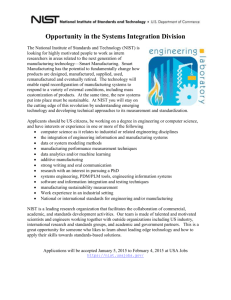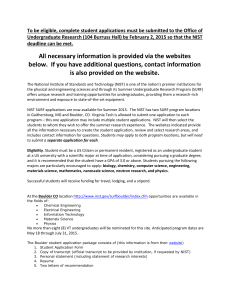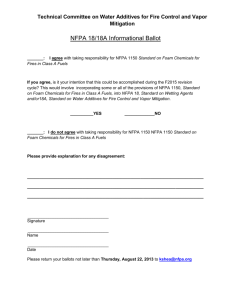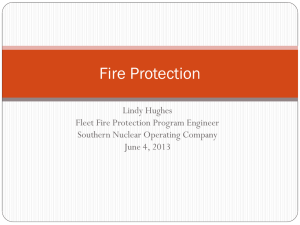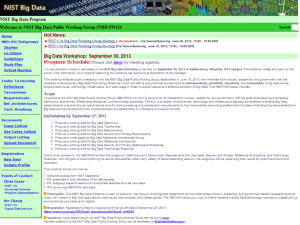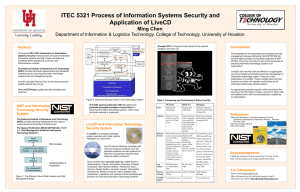the executive summary
advertisement
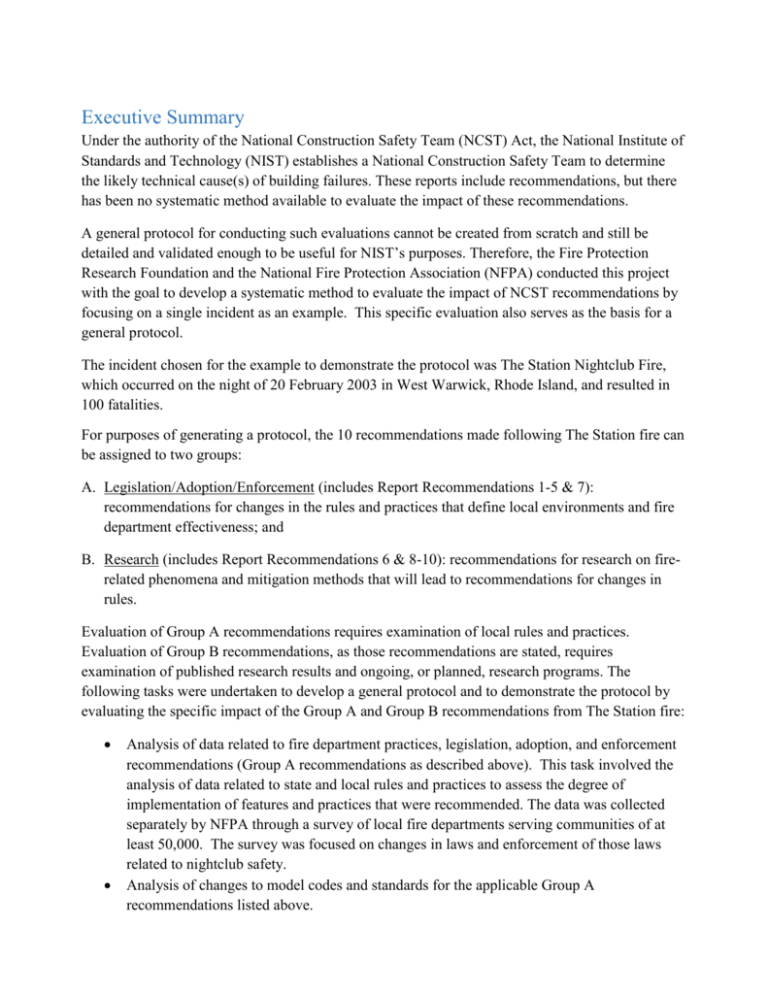
Executive Summary Under the authority of the National Construction Safety Team (NCST) Act, the National Institute of Standards and Technology (NIST) establishes a National Construction Safety Team to determine the likely technical cause(s) of building failures. These reports include recommendations, but there has been no systematic method available to evaluate the impact of these recommendations. A general protocol for conducting such evaluations cannot be created from scratch and still be detailed and validated enough to be useful for NIST’s purposes. Therefore, the Fire Protection Research Foundation and the National Fire Protection Association (NFPA) conducted this project with the goal to develop a systematic method to evaluate the impact of NCST recommendations by focusing on a single incident as an example. This specific evaluation also serves as the basis for a general protocol. The incident chosen for the example to demonstrate the protocol was The Station Nightclub Fire, which occurred on the night of 20 February 2003 in West Warwick, Rhode Island, and resulted in 100 fatalities. For purposes of generating a protocol, the 10 recommendations made following The Station fire can be assigned to two groups: A. Legislation/Adoption/Enforcement (includes Report Recommendations 1-5 & 7): recommendations for changes in the rules and practices that define local environments and fire department effectiveness; and B. Research (includes Report Recommendations 6 & 8-10): recommendations for research on firerelated phenomena and mitigation methods that will lead to recommendations for changes in rules. Evaluation of Group A recommendations requires examination of local rules and practices. Evaluation of Group B recommendations, as those recommendations are stated, requires examination of published research results and ongoing, or planned, research programs. The following tasks were undertaken to develop a general protocol and to demonstrate the protocol by evaluating the specific impact of the Group A and Group B recommendations from The Station fire: Analysis of data related to fire department practices, legislation, adoption, and enforcement recommendations (Group A recommendations as described above). This task involved the analysis of data related to state and local rules and practices to assess the degree of implementation of features and practices that were recommended. The data was collected separately by NFPA through a survey of local fire departments serving communities of at least 50,000. The survey was focused on changes in laws and enforcement of those laws related to nightclub safety. Analysis of changes to model codes and standards for the applicable Group A recommendations listed above. Literature review for the Group B recommendations discussed above. A literature review was undertaken to examine published research results and ongoing, or planned, research programs related to the recommendations. Synergistic review of the findings from the previous tasks, which involved studying the findings for any links. Throughout the report, at each step the general protocol developed is explained and then demonstrated using the example of The Station Nightclub. This pilot study was undertaken to develop a general model impact evaluation protocol to be adapted to the recommendations from the other NIST NCST report and similar report. As with any pilot study, lessons were learned along the way that should apply to the model for these types of evaluations going forward. This section contains the recommended protocol for an impact evaluation that can be applied to other sets of NIST recommendations. A general recommendation for this type of evaluation is that this analysis should be completed more than once. The reason for this is two-fold. First, it takes time for major changes to be implemented in the model codes and standards. This can sometimes take several cycles. Secondly, research takes time to conduct and consequently it takes even more time for that research to have an impact on rules in the model documents. Further, sometimes changes made to local rules and practices are rescinded due to local political environments, etc. An example of this is the Chattanooga, Tennessee City Council rescinding a prior ordinance requiring sprinklers at bars and clubs in 2013. Another general recommendation to NIST is related to wording of the recommendations. In order to evaluate the impact of the recommendation, it is best that the recommendations made are clear and measureable. Specifically, it may be helpful to have separate recommendations relating to education and training as a bump in training may occur after an event. Step 1: Analysis of Changes to Model Codes The pilot study documented in this report performed the analysis of changes to model codes and standards as a second task, but ideally, this should be undertaken as a first step in the evaluation. This is because changes are usually made in the model codes as a first step and then the local jurisdictions adopt the model codes. The general approach of this step is to analyze the requirements related to the NIST recommendations before the recommendations were issued, and compare them to later editions of the codes and standards. This should be done for all editions issued after the event because, as noted above, it sometimes takes several cycles for changes to be implemented. Step 2: Analysis of Changes to Local Practices The goal of this type of exercise is to provide an evaluation of the degree of implementation of features and practices that were recommended – usually in the form of a new code or standard or changes to an existing code or standard. What is sought is information on: adoption of requirements (for those features and practices), which connects the gap between impact of recommendations at the national level (on model codes and standards) and impact at the local level (on local requirements and practices); compliance with requirements (for features of properties but not for fire department practices; if fire departments report adoption of requirements for fire department practices, then there is no point in asking fire departments about inspection and enforcement activities to check compliance); and timing of changes in requirements, as this is the most accessible information indicating a role on NIST recommendations and other national changes or guidance following a major incident in changing local practices (e.g., some localities may already have local practices that match the recommendations) An evaluation exercise can be conducted using a number of different types of information, but the best balance of affordability and useful detail will likely be achieved through a survey. However, it is important to check costs, response rates, design bias, and resulting statistical significance of a particular survey proposal. It is also important to check whether the level and type of detail obtainable from a survey will provide sufficient evaluative depth to be worth the cost. For this prototype application of an evaluation protocol, NFPA was able to use data collected in the earlier, independent NFPA survey as the issues addressed match well with the NIST recommendations on similar topics. In a normal application of the generic protocol, those conducting the evaluation would have to review the considerations listed here for and against a survey as a source of evaluative information. They would also have to design a survey, if they chose to conduct one. Appendix A contains the survey used by NFPA, which is offered here for its illustrative value to anyone seeking to develop a survey with the same structure for evaluation of any set of recommendations arising from investigation of a major incident. Determining the target. The first step in implementing a survey is to determine the target for the survey. For recommendations defined by a class of properties, the first step starts with identifying the number of such establishments in the country, followed by looking for any clustering of establishments that would permit a narrower focus in the evaluation (e.g., most properties located in certain states or in communities of a certain size). General protocol to evaluate targeted conditions. An evaluation is built around best estimates of answers to three questions, for a particular recommended feature or practice that was called for in a recommendation. Question 1. To what extent do communities have requirements related to the feature or practice? Typically, a requirement will be set forth in an adopted code provision, standard, or other legislative authorization. The “condition” could be a characteristic (e.g., system, feature) of the property that enhances safety, a practice of the fire department that reinforces the property characteristics (e.g., enforcement), or one that improves the ability to mitigate incidents when they occur. This question should also include any specific local law that may not be based on a model code or, alternatively, if the changes are being removed at the local level due to the level of resources available. Question 2. What is the degree of compliance with those requirements in the communities? For property characteristics, there may be no existing basis for direct measurement of compliance because many, possibly most, communities do not have annual fire code inspections of all properties or of a representative sample of properties. A special survey of properties could be used, but in most cases, the only practical measurement will be best estimates by community authorities. For fire department practices to improve mitigation ability (such as communications at the fire scene, deployment and staffing, incident management), the fire department is involved directly in adoption, which means the entity that needs to implement the requirements and assure compliance is not a separate entity. As a result, they may require more persuasion or motivation to comply with a requirement in which they had nothing to do with creating. In both cases, an audit involving direct observation of practices and conditions by an independent third party would provide more evidence of compliance, but at a considerably greater cost per community. Question 3. Did the requirements change after the major event that led to the recommendations? This is the best high-level indicator of the impact of the recommendations. It is not necessarily the case that improvements in safety introduced after a major event were made in response to that event, let alone that they were made in accordance with specific recommendations emerging from that event, but it is a reasonable premise for a first-order evaluation of the impact of recommendations. Additionally, a more detailed evaluation would be much more expensive. Step 3: Literature Review Related to Research Recommendations To evaluate the impact of recommendations relating to research, the recommended approach is to conduct a literature review, which should include the following types of materials: Published research (e.g., academia, government laboratories, private industry) Programs, plans, and agendas for research not yet completed; Research assembled or conducted as input to revisions of model codes, standards, and similar documents (e.g., ASTM, ICC, ISO, NFPA, SFPE) Research on the effectiveness of model codes, standards, and similar documents The research recommendations are intended to lead to research that will in turn result in new rules and practices. To provide some assessment of the degree of progress toward this goal, the literature sources should be evaluated on the following: Quality (e.g., originality, peer-reviewed), including notes on availability as applicable (e.g., proprietary vs. non-proprietary) Relevance (e.g., relevance to topic, degree of progress toward eventual goal of recommendations on rules and practices) using a rating system Step 4: Synergistic Review and Analysis For the pilot study, a comparison was made between the changes in model codes and standards and the local analysis. However, as suggested above, the analysis of changes to model documents should be completed ahead of the survey used to evaluate the changes in local practice. Then, this analysis will feed into how the survey questions are formed. Research on a topic can inform changes to model codes and standards as well as local practices. The deliverables from the literature review on any research related recommendations and the findings from the analysis of changes to model codes and local practices (Step 1 and Step 2 should be reviewed and analyzed for any links. However, this is often a long process, thus it is recommended above that this type of evaluation be completed more than once. This type of comparison can also give an idea of what changes may be on the horizon associated with more recent completed research.

